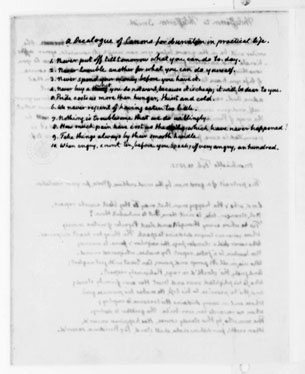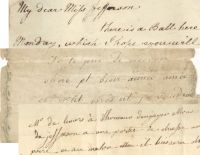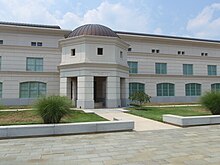Saving Monticello : The Newsletter
The latest about the book, author
events, and more
Newsletter Editor - Marc Leepson
Volume XII, Number 12 December
1, 2015
JEFFERSON’S RULES: Browsing
through the Thomas Jefferson Foundation’s excellent on-line Thomas Jefferson
Encyclopedia, I came across something I hadn’t seen before, Thomas Jefferson’s
“Canons of Conduct,” a list of axioms for personal behavior.

Jefferson sent versions of the list to his children and
grandchildren; the entry in the TJ Encyclopedia—written by SM Newsletter
subscriber Anna Berkes, the research librarian at Monticello’s Jefferson
Library who manages the Encyclopedia—includes a reproduction of one of the
lists from a letter Jefferson sent to his granddaughter Cornelia Jefferson
Randolph. To wit:
A DOZEN CANONS OF CONDUCT IN LIFE
1. Never put off to tomorrow what you can do to-day.
2. Never trouble another with what you can do yourself.
3. Never spend your money before you have it.
4. Never buy a thing you do not want, because it is cheap,
it will be dear to you.
5. Take care of your cents: Dollars will take care of
themselves!
6. Pride costs us more than hunger, thirst and cold.
7. We never repent of having eat[en] too little.
8. Nothing is troublesome that one does willingly.
9. How much pain have cost us the evils which have never
happen’d!
10. Take things always by their smooth handle.
11. Think as you please, & so let others, & you will
have no disputes.
12. When angry, count 10 before you speak; if very angry, 100.
Jefferson, Berkes writes, “sent a slightly shorter version
of the above list to Paul Clay, the son of his friend Charles Clay, in
1817, and a still more refined version in 1825 to John Spear Smith.” In
his 1825 letter, Jefferson listed a “decalogue of canons for observation in
practical life.” To wit:
Never put off till tomorrow what you can do to-day.
Never trouble another for what you can do yourself.
Never spend your money before you have it.
Never buy what you do not want, because it is cheap; it will
be dear to you.
Pride costs us more than hunger, thirst and cold.
We never repent of having eaten too little.
Nothing is
troublesome that we do willingly.
How much pain have cost us the evils which have never
happened!
Take things always by their smooth handle.
When angry, count ten, before you speak; if very angry, an
hundred
It’s interesting to note that Thomas Jefferson himself conspicuously
did not follow at least two of the Canon items: spending money before you have
it and watching his pennies.
As I noted in Saving
Monticello, Jefferson loved spending money (that he had—and that he did not
have) and wound up over $107,000 in debt when he died. That financial burden
forced his family (led by his daughter Martha Jefferson Randolph and grandson
Thomas Jefferson Randolph) to sell all of the land they inherited, as well as
the furniture and furnishings at Monticello—and then, in 1831, Monticello
itself.
To read the entire entry, go to www.monticello.org/site/jefferson/canons-conduct
EVENTS: I have just two events in December, as I am
now in full-time writing mode on my next
book, a biography of Barry Sadler, the U.S. Army Sergeant who wrote and
performed “The Ballad of the Green Berets.” The pub date is November of 2016.
- Tuesday, December 1 – book signing (of all of my books) at the
Williamsburg, Virginia DAR Chapter’s annual Holiday Bazaar event at
Colonial Country Club.
- Thursday, December 10 – a talk on Saving Monticello for the Hanukkah Program at the Pentagon
Chapel in Washington, D.C.
If you’d like to arrange an event for any of my books, email
marc527psc@aol.com For more details on upcoming events, go to http://bit.ly/SMOnline,
the “Author Events” page on my website, www.marcleepson.com
Facebook,
Twitter: If you’re on Facebook, please send me a friend request. If
you’re on Twitter, I’d love to have you as a follower.
Gift
Ideas: If you would like a
personally autographed, brand-new paperback copy of Saving Monticello, e-mail me at Marc527psc@aol.com
Or go to http://marcleepson.com/signedbooks.html
to order copies through Second Chapter Books in Middleburg, Virginia. We also
have copies of Desperate Engagement, Flag, Lafayette



















